
Let’s get this out of the way: I was wrong, and I need to update my review of the Specialized Carbon 6Fattie. In my initial review of this bike, which has since been amended, I gave it kudos for traction, versatility, climbing, and said it was a good bike–but also I wrote the bike “requires some key modifications before it can realize its full potential–and not be dangerous,” indicating the bike might pose some danger due to its rim width. I've since redacted that comment from the review, along with a few others.
In my defense, I broke my scapula on the bike. I felt I couldn’t get the tires cornering at speed without them ‘pushing’ (squirming laterally).

To Specialized’s credit, after reading my review, they took the high road. I had a long discussion with the rep and he encouraged me to keep the bike–one of the plus-sized versions of the brand's popular Stumpjumper trail bike lineup–for awhile and keep riding it. He mentioned the bike had gone through extensive testing and nobody had the same problems. So he felt there must be something else.
They put their heads together to figure out what might be making me feel less than great on the bike. We also had a long discussion about whether a review is perceived by readers as a broad-sweeping declaration (their theory) or just one person’s opinion (my theory). It's actually something worth thinking about.
Anyway, we came up with the idea of softening the suspension a bit and putting more air in the tire. I was running about 17-19 pounds in it. And I upped it. I ran the tires at 21 PSI and the fork at about 75 PSI, down from about 80 or so.
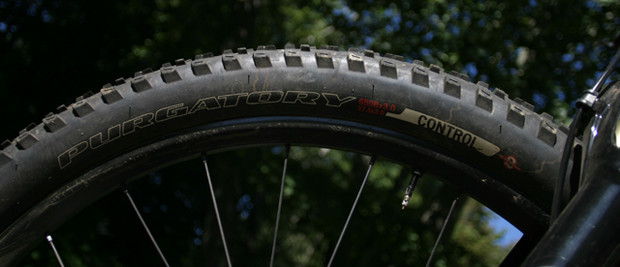
Specialized has since sent me a tire pressure recommendation chart that I'll publish here:
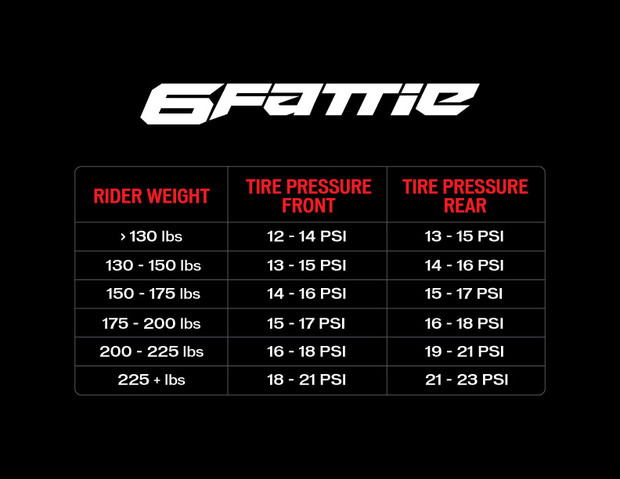 I would even recommend going a few PSI higher than what's recommended. You won't lose any traction by keeping the tires more inflated.
I would even recommend going a few PSI higher than what's recommended. You won't lose any traction by keeping the tires more inflated.
I also told them I’d lend the bike out to a few friends and get their feedback on it while my shoulder healed, so that my own opinion could be balanced out by a broader sample size.
The first friend I lent it to called me from the parking lot as soon as he was done with the ride. He was raving about it. “Will they sell you this?” “Can we pool our cash and buy it for all of us to share?”

Another friend actually bought one (full disclosure: not exactly the same one, the aluminum version). Overall, I lent it to three other friends for anywhere from a day to a week or so of riding. They all loved it and really wanted it. In fact, I heard about a few discussions on who got to ride it on certain Saturdays. Their comments included things like:
"Was very comfortable, felt very similar to my Pivot Mach 6 geometry. Rode great on rock gardens and long descents. Climbing after a rainy night, tires gripped better then I have ever experienced before. Lots of room for error when descending and jumping."
"The bike is best at climbing technical trails and descending technical trails."
"I thought it was a perfect combination/hybrid of an enduro/cross country/fat bike. I would consider owning this bike."
"With the higher end components, it’s a 10!"
"My only reservation with the bike is that it makes me feel as though I’m cheating… one of the things I love about riding is constantly trying to improve my skills with every ride. With this bike, I don’t have to be as sharp because the bike does a lot for me."
"The bike is a great climber and 'rocks' the rock gardens. Either it can get over or through almost everything, or I’m an amazing rider…"
So, once I healed, I started riding it again, getting used to it and keeping the tire pressure high. And truthfully, I’ve really started to love riding it. I’m upping my call on this bike to being awesome.
There are also a few additional capabilities I should mention: October and November, it was absolutely fantastic in the usually annoying coating of new leaves and acorns. When buddies were sliding around like circus clowns, hating life, the 6Fattie was unfazed, like it didn’t matter.
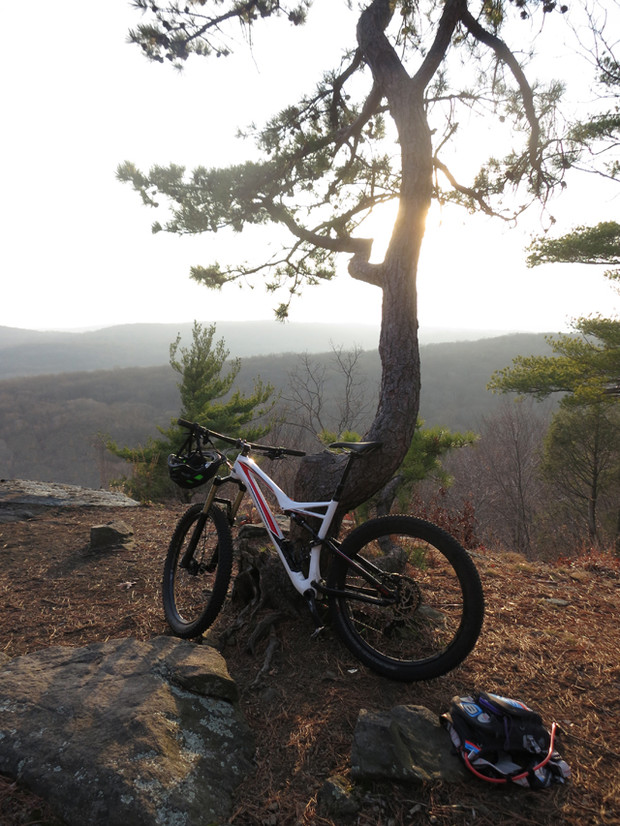
Additionally, I had stated in the first review that the extra grip from the tires might have made the fork plow through its travel too quickly under braking forces–and so I firmed it up. In hindsight, this might have exacerbated the problem of under-inflated tires. If the tires are soft and the fork and shock are too hard, then the fork won't start moving when it's supposed to and put additional forces into the tire. Nice firm tires and a supple suspension work great on the 6Fattie.
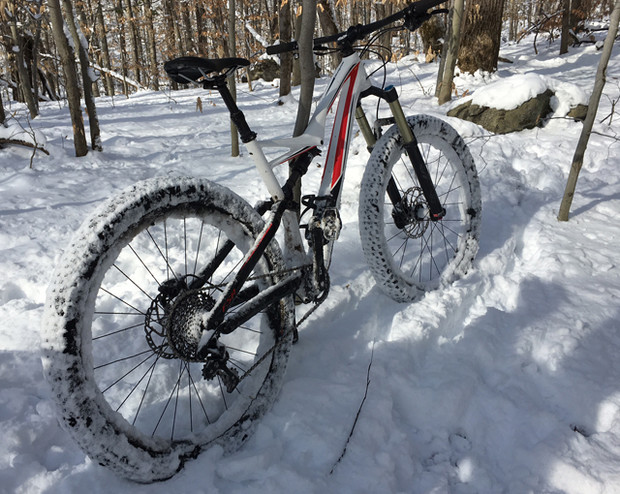
For what it’s worth, it’s a decent snow bike, too. It's not a total fat bike, but it could hang on snow rides as long as it wasn't first through the fresh stuff.
Finally, not that you should ride in the rain and wet, but if you do, the bike has a distinct advantage in grip.
With the right tire pressure, I’m jumping the thing, railing corners, and really loving chunky technical descents. At higher pressures, fantastic traction is still there so you can lean it radically.
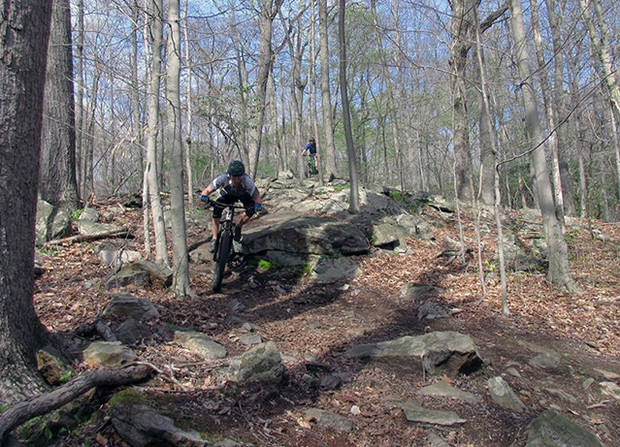 Landing on rubber side down is always better. Dave Peters photo.
Landing on rubber side down is always better. Dave Peters photo.
Things that are the same as before:
-Huge fan of the swat downtube storage. I love not having to carry an inner tube on my person.
-The dropper post is great, not a hiccup. I love the trigger.
-SRAM's cheaper GX is a great groupset–it shifts smooth, reliably and quietly several months later.
-Shimano's Deore brakes are fantastic, and feel like a much higher end group.
-There is a big advantage from switching the shock settings between open and closed. The 6Fattie climbs really well with it closed, and descends well with it open. That’s a good thing.
Again, let me be clear. Specialized does not buy any media from TGR, so there is no pressure on me to amend this review other than my own feeling I didn't get it 100% right.
In fact, they were nice enough to get their test riders to answer a questionnaire I sent to them to try to figure out what was going on with the bike. Below, unedited, are their answers. Sure, it's from the company that made the bike and the riders work for Specialized. But I don't think there's any inordinate skewing of reality going on.
CARLIN DUNNE, Santa Barbara, CA: Former pro MTB rider, current pro motorcycle racer, and pikes peak hill climb motorcycle world record holder
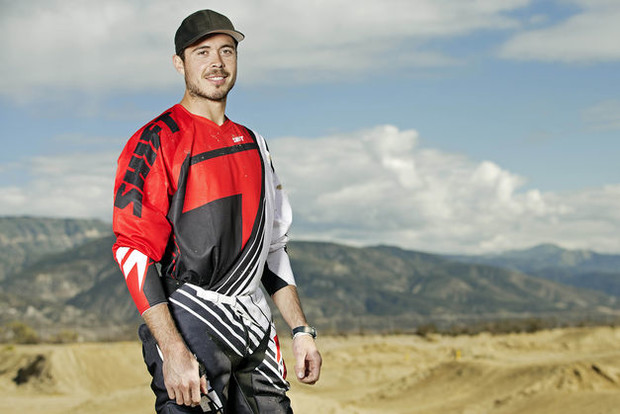
How did you set up the bike for yourself – what was the process?
Bike set up was critical to take full advantage of what the new plus tire option had to offer. I found the tires had excellent small bump absorption once the pressure "sweet spot" was found; where that sweet spot is is influenced mostly by the type of trail you're riding, but also desired rolling resistance, sidewall roll, feel, and tractability.
It’s a moving target, for each individual but when its there you know. Running the 6Fattie tire is like adding two inches of travel to your bike on the descents. When the pressure is right, it eats the chatter, small rocks, and deflects far less than a conventional setup. This added benefit allowed me to run my suspension harder than normal, achieving great bottoming resistance and better suspension action while cornering.
Under what setup did you feel the bike performed best?
At 6’3” 185 lbs, the bike performed best for me with the 6Fatties at 22 PSI. I ran the suspension at the manufacturer’s pressure suggestion for someone 10-20 lbs heavier than myself. The trails I ride most here are big, rocky, and fast. At the right speed, there's a smooth harmony amidst a normally chaotic route. I'm a retired meat hucker, so my riding style is a flow-slash-stomp.
Sometimes I find the fastest line is to boost off something to clear rough terrain rather than bouncing over the top of it. With this in mind, I tend to run more pressure in both tires and suspension than most riders.
What do you feel the bike was best at?
The bike performed best for me on fast rocky descents. It deflected less and gave a solid footprint. As long as the trail was solid, it didn't matter what obstacles were in my way, I could ride faster and more confidently than on a conventional 29'er. Think of it like a running shoe; some like a thin minimalist shoe, or some like a higher cushion shoe. You can easily envision the pros and cons of both.
If I was running a loose, rocky, marble-y trail, I would want a thin shoe so I could feel every little rock move under my feet. If I was on a trail with large rocks, hard dirt, and a overall "solid" feel, I would want a more cushioned shoe as I would naturally be able to be more sure-footed.
The same applies to these tires. Our trails here in Santa Barbara can be very diverse. On some trails, the Fattie is without a doubt better and some it is not. In its current design, the 6Fattie is a great option for the enthusiasts whose favorite trail lends itself to these tires' strengths. Also a great choice for the avid shredder who has the luxury of a couple wheelsets and is dead set on KOM-ing certain trails.
DYLAN BUFFINGTON, San Francisco, CA: Former DH racer, currently races Red Hook Crits and Cat 1 Cyclocross for MASH SF
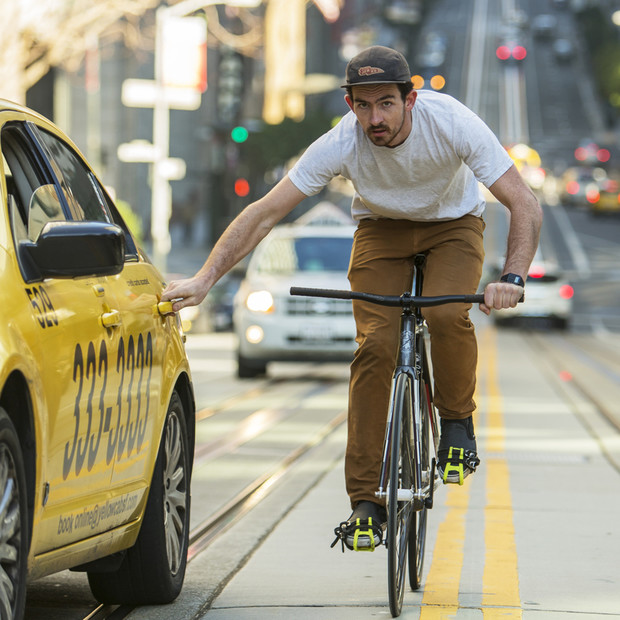
How did you set up the bike for yourself – what was the process?
I was running the tires on a 29'er Enduro Expert. I typically ran the tires between 15 and 20 PSI, which has alway been out of my comfort range. Also, with a dirt jumping background, I like to run my suspension a little tighter. So, this set up–low pressure, high grip, stiff, poppy suspension–was the perfect set up for my all-around use.
Under what setup did you feel the bike performed best?
Once I dialed in the suspension, I was better able to play with the tire pressure. When I had first set it up, I would typically run it too high, between 30-40 PSI, but once I got comfortable with running 18-25 PSI, the whole setup really started feeling at home. No matter where I was riding rock gardens, loamy sections through trees, or wet roots, I couldn't find a scenario where the tires didn't have control.
What do you feel the bike was best at?
Pedaling was a huge surprise. I was able to climb some really steep things that on any bike that size typically would be next to impossible. This made the bike more accessible to more terrain. Off camber turns were so sick. I did a little bit of jumping with it, hitting 10-15 foot gaps, and it handled really, really well. I wasn't mad about it. Manual points were really tight but sustainable. It held better in a wheelie.
If you were riding a pre-production prototype, or even if you weren’t, what feedback or suggestions did you offer to make the bike better?
All in all, the bike was great. A swing arm that could hold the tires with more clearance might be nice, as it was a tight squeeze on an Enduro 29 frame. Add a more user-friendly rear shock, as the Cane Creek had some setup challenges and reliability issues, and that bike would be amazing.
SEAN ESTES, Specialized Global PR Manager, Morgan Hill, CA: Pro/Cat 1 XC, CX, Enduro and DH racer, Cat 3 road racer
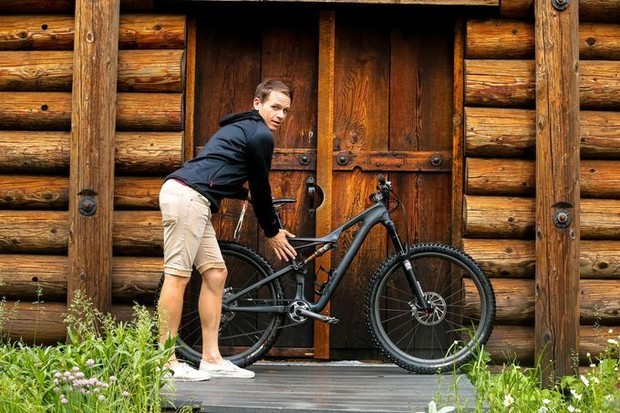
How did you set up the bike for yourself–what was the process?
Tire Pressure: I started with about 15 PSI front and rear and tuned from there until I found the right balance of compliance and stability, i.e. not so low as to risk pinch flats or tire squirm, but not so firm as to negate the benefits of the high-volume tire. I settled on about 17 front and 18 rear for my normal riding, and more like 19 front 20 rear for rocky terrain such as my race runs at the Downieville Classic.
Suspension: for baseline, I set autosag on the rear shock, then since I personally prefer a highly active suspension, I generally sag the rear just a touch more (5-10%) than autosag. I tend to set from pressure based on the attitude of the bike, meaning I start firm (~100psi for my weight of 160 lbs in full kit) then slowly reduce pressure to the point the fork just starts to dive under hard braking, then I add pressure until it’s at the sweet spot.
For steeps, I will increase for pressure by about 10 PSI over my usual setup.
Under what setup did you feel the bike performed best?
Like I said above, that really depends on terrain. For really rocky terrain, you want more tire pressure, for really steep terrain you might want more fork pressure, for rocky steep terrain you might want both. As long as the setup is right, this bike feels amazing on most types of terrain.
What do you feel the bike was best at?
I honestly feel the bike performs best in most situations. I have ridden it about 500 miles this summer across all types of terrain, including a week in B.C. riding super steep trails in Whistler Valley, and racing it at the All-Mtn World Championships at Downieville, where I got 15th in the XC and 23rd overall, even with a mechanical that cost me 15 minutes.
I have found the bike to be as fast as a 29'er on pavement, climb as well as any other bike or better due to the increased traction and low gearing (I cut one minute out of my race time on the one-hour climb at Downieville over the year prior) and it absolutely RIPS on the descents. I cut seven minutes out of my descent at Downieville over last year and every Strava segment I have ridden I have been faster on the 6fattie than on my 29'er.
If you were riding a pre-production prototype. or even if you weren’t, what feedback or suggestions did you offer to make the bike better?
I have ridden both the Enduro test bike with 6Fattie wheels/tires and the production Stumpjumper S-Works 6Fattie. The Enduro had a lot of travel and slack geo so with the big wheels it felt a little over-gunned in many ‘trail’ riding scenarios–awesome if not a bit sluggish in some instances.
The production Stumpjumper 6Fattie has trail geo and travel, so it feels spot-on. The only thing I would change is a full carbon rear-end on the production bike to save a few ounces. Other than that the bike is perfect and my favorite mountain bike of all-time. I have been riding for over 25 years and owned A LOT of bikes so I feel like that says a lot.



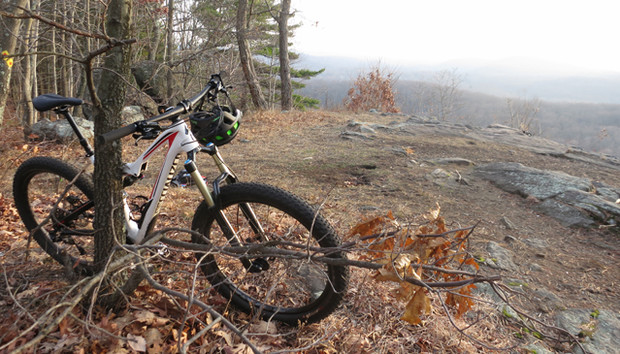

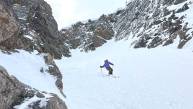
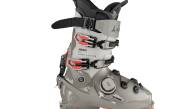
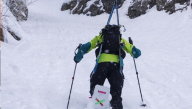


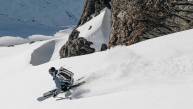

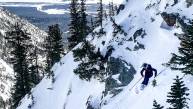
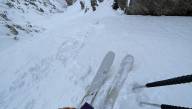


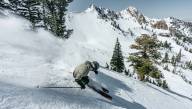
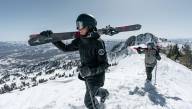

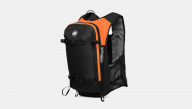
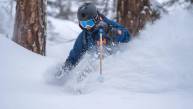
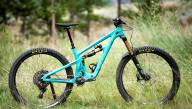


sercombeNZ
February 16th, 2017
Hi there. I have the carbon comp stumpy 29’er with additional wheel set purchased of the 29mm rims with 3” purgurtory Front and Rear..all tubeless. I get my fastest uphills with them not the 29 2.3 set up. I find pedal strike slightly annoying but ok…however as there is so little tyre selection for 3” I thought I might get the butcher 2.8? I feel better grip on the butcher 29 2.3” than the purg 3”! on the 3” I run 15psi front/17 rear and I weight 165 pounds or 75 kilo’s. My concern is the lower BB height…would it be acceptable to drop another 6mm using the 2.8” idea…I think NOT? However is there any reason why I shouldn’t try just the front as 2.8 and leave the rear as 3”?...that would only drop the BB height 2-3mm I reckon…seems unethical but what do you think and are you happy with the purg on front? and rear?...GC is suppose to be more fast rolling but as I am enjoying pr’s on rear purg is there any reason to try anything else on the back?? your thoughts and anyone elses opinion appreciated.
If I was buying again this would be considered: that the 29’er (which I love) is in fact not the same geo as the 650B in BB height clearance…as I love the plusher ride of 3” but wonder should I have settled on the 650B with max 2.6tyres…as way higher BB….I think I made the right call for the 29’er Fattie but curious as friends are asking me as they are in the buying process now and are asking me lots of questions…any experience on the difference?
Cheers :)
Roger in New Zealand
m13f98
June 2nd, 2017
opening hours